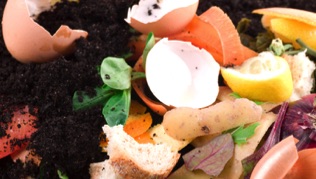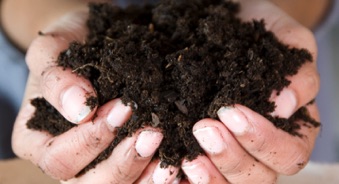

April 3, 2015 - Composting - Give it a Spin
Everyone is always talking about some new natural product or some new natural thing, well composting is about as natural as it gets and is as old as dirt. It''s the best natural fertilizer that there is and there are many ways to soup up your compost to push more nutrients for your plants. It is also a great way to control weeds and hold moisture in year round for your plants while feeding them naturally.
All it takes is finding a place to pile your organic matter somewhere strategically where air can get to this heaped up pile to let air and some heat start the breakdown and oxzidation into this earthy matter of material, that is rich and full of nutrients to help sustain your desired plants every growing season.
There are all sort s of compost bin ideas for every situation. Many ideas you can build to fit your space or you may want to buy commercial products to keep your heap pile more containerized. Here at Bahrstead's we use a combination of both.
We like the commercial product if we are trying to extract a compost tea that is really all the aqueous nutrients that collects at the bottom of the composter and it works like a juicer. This concentrate is perfect for spray or drip application. The challenge is having the time to mess with it. We are still experimenting with Compost Teas and suggest doing yourn own research. We find Mother Earth News,Acres, or websites give pretty good information and ideas to possibly help with your plans. Their articles and sites get more technical than this article, except to say, planning your compost site should be happening now.
Here’s how composting works. Your compost should consist of 3 basic elements that get layered if you are doing a static compost heap pile:
1) Green Matter - grass clippings (grass can’t have any weed-n-feed residual) vegetable plants (part of whole as long as they are chopped up some what, other green plants that don’t contain a lot of undesired seeds and even fruit rinds,
2) Brown Matter - Autumn leaves, lignin (tree limbs chopped finely) some barks, hay and other stalky material. We raise chickens and the hay that comes out of their coop is an excellent souce of nitrogen. We use it with caution. We don't want to over do it, because it can increase the acidity of the compost and may kill the other micro-organisms in the pile. The more you can chop up the brown matter will determine how loose the compost will be. Also, egg shell is rich with calcium and we hear that it keeps some pest at bay, like leaf-eating slugs. Usually, you are shooting for nothing more than a inch in size. The brown matter also prevents compaction and keeps the matter loose.
3) Black Matter - soil that contain healthy microbes, a little bit of naturally occurring wild yeast. If I wonder if there is enough wild yeast to help ferment this concoction, I dump a left over beer or wine on top of the heap. There should be some residual yeast there, or maybe grab a packet of bread yeast when your better half isn't looking and sprinkle it on top. I also like to put a little bit of lime in the mix to help keep the alkalinity in check.
We try to keep our green, brown and black matter seperate and then layer materials in during the season as we build the heap up. In the end of the growing season, you will start turning this material to expose your heap to some air, which is vital as it winters and cooks. Remember that this is a pile that is alive and oxygen is needed to keep your pile healthy and keep the smell in check. There should be an odor, but it shouldn't be a rotten odor.
We found that if we want a quick turning compost, then size does matter. Smaller in this instance is better because materials breakdown faster. However, finding thse right balance of sized pieces matter. We find that when pieces are getting more than an inch, then it can mess up your seedlings and planting. With my mower deck and the use of a wood chipper, I can get the best results and I am happy when we spread the compost.
The containment area is important as well. For the small backyard or apartment there are small composting units that are great for planters or garden area space. Then, there are larger containment areas for bigger areas that are more like a fenced in area where you continue to add from the top and pitch fork around to bring the compost on to the top of the pile to regenerate the reaction.
So if you are interested in putting some ummmph in you garden and want to have a way to dispose of your clippings, wood, and table scraps... consider the benefits of this "alternative" and ."natural" product by giving Composting a Spin.
Cheers!




